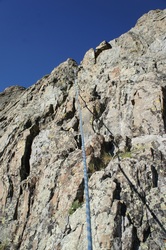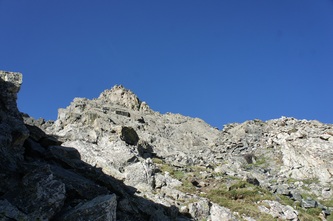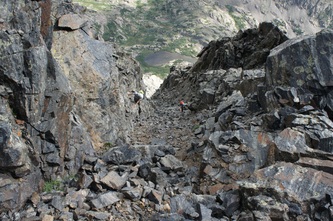Quandary Peak via Inwood Arete (5.4)
July 26, 2012
Crew: Mark, Jen
Although Quandary is one of the most gentle, loved and hiked 14ers, it has a secret. It's kind east slopes give way to a steep mess of broken rock on it's northern side. The premier route on the north face is called Inwood Arete, and it follows a vague fin of rock up the steep face. Wanting to explore this unusual side of Quandary and with July almost being over, I decided it was time for my first 14er in 2012. My wife and good buddy Mark jumped at my idea and we slept well knowing that it was only a 15 minute drive from Mark's house in Breckenridge to the trailhead. Walking out of Daylight Donuts was a nice change of pace from the usual early start, and we smirked as we passed the circus of cars at the east slopes trailhead and pulled into an empty McCullough Gulch. Not far up the trail, Inwood Arete posed dramatically on the skyline but as we approached closer, the obvious arete vanished into obscurity onto the broad/broken face. We made a direct line for the base of the arete and started near its left edge on some talus.
Not sure of what to expect on the ridge, we had come prepared with a 50M x 9.5mm rope, a set of nuts, 4 tri-cams and 4 slings. Knowing that the most technical portion would be the start, I tied in and started up. Although steep, the ledgey nature of the terrain allowed me to feel comfortable leaving my tennis-shoes on and running it out. After about 300 feet the angle eased and relented to easier scrambling. The rest of the route offered numerous possibilities from loose class 2 gullies on the right, to harder scrambling (class 3-5.0) on solid rock further left. We climbed the towers on the ridge directly on the exposed eastern edge. From there the scrambling finally gave way to easier (but loose) gullies that deposited us on the popular eastern slopes at about 13,800 feet. We quickly motored to the summit and joined the hordes. Being a Thursday, I expected a few folks but was shocked to see 32 on the summit and another hundred milling up and down the slopes. The mountain goats on the summit roamed freely around the crowds without even batting an eye. Many kind folks were hiking up and down and it was nice to see so many people enthused about the mountains. It was a great experience to climb such a popular peak by a route so uncharacteristic to what everybody expects.
Crew: Mark, Jen
Although Quandary is one of the most gentle, loved and hiked 14ers, it has a secret. It's kind east slopes give way to a steep mess of broken rock on it's northern side. The premier route on the north face is called Inwood Arete, and it follows a vague fin of rock up the steep face. Wanting to explore this unusual side of Quandary and with July almost being over, I decided it was time for my first 14er in 2012. My wife and good buddy Mark jumped at my idea and we slept well knowing that it was only a 15 minute drive from Mark's house in Breckenridge to the trailhead. Walking out of Daylight Donuts was a nice change of pace from the usual early start, and we smirked as we passed the circus of cars at the east slopes trailhead and pulled into an empty McCullough Gulch. Not far up the trail, Inwood Arete posed dramatically on the skyline but as we approached closer, the obvious arete vanished into obscurity onto the broad/broken face. We made a direct line for the base of the arete and started near its left edge on some talus.
Not sure of what to expect on the ridge, we had come prepared with a 50M x 9.5mm rope, a set of nuts, 4 tri-cams and 4 slings. Knowing that the most technical portion would be the start, I tied in and started up. Although steep, the ledgey nature of the terrain allowed me to feel comfortable leaving my tennis-shoes on and running it out. After about 300 feet the angle eased and relented to easier scrambling. The rest of the route offered numerous possibilities from loose class 2 gullies on the right, to harder scrambling (class 3-5.0) on solid rock further left. We climbed the towers on the ridge directly on the exposed eastern edge. From there the scrambling finally gave way to easier (but loose) gullies that deposited us on the popular eastern slopes at about 13,800 feet. We quickly motored to the summit and joined the hordes. Being a Thursday, I expected a few folks but was shocked to see 32 on the summit and another hundred milling up and down the slopes. The mountain goats on the summit roamed freely around the crowds without even batting an eye. Many kind folks were hiking up and down and it was nice to see so many people enthused about the mountains. It was a great experience to climb such a popular peak by a route so uncharacteristic to what everybody expects.
Thoughts
Gear taken: 50M x 9.5mm rope. We used it to belay my wife up the first 300 feet but Mark and I soloed it.
Rock shoes. We never put them on. I climbed in light hikers, Mark used approach shoes and Jen used boots.
Rock protection: 1 set of nuts, 4 tricams (0.5-2). I only used 2 tricams and 1 nut to build a belay anchor.
Random slings. Never used them.
Helmets! The routes has loose rock so this was a must as always on routes like this.
Route: Many possibilities exist. Solid scrambling almost always has an easier option but it often looked loose. I would guess the whole ridge could be
climbed without exceeding loose class 3 (this is a guess!). The best climbing (and most solid) was right on the arete.
Gear taken: 50M x 9.5mm rope. We used it to belay my wife up the first 300 feet but Mark and I soloed it.
Rock shoes. We never put them on. I climbed in light hikers, Mark used approach shoes and Jen used boots.
Rock protection: 1 set of nuts, 4 tricams (0.5-2). I only used 2 tricams and 1 nut to build a belay anchor.
Random slings. Never used them.
Helmets! The routes has loose rock so this was a must as always on routes like this.
Route: Many possibilities exist. Solid scrambling almost always has an easier option but it often looked loose. I would guess the whole ridge could be
climbed without exceeding loose class 3 (this is a guess!). The best climbing (and most solid) was right on the arete.






























